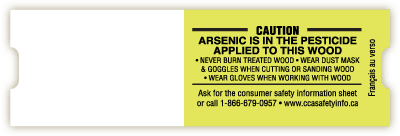Consumer Safety Information Sheet

Chromated Copper Arsenate (CCA)
This wood has been preserved by pressure treatment with Chromated Copper Arsenate (CCA). CCA contains inorganic arsenic, chromium and copper and is a pesticide registered for use in Canada under the Pest Control Products Act. Treatment with CCA extends the life of wood, thus reducing demand on forest resources. Exposure to arsenic and chromium may present certain hazards. Below are steps you can take to reduce significantly releases to the environment and human exposure to these chemicals.
NEVER BURN TREATED WOOD. Arsenic and chromium may be released into the environment as part of the smoke or remain in the ashes.
Use
Wood treated with CCA should be used only when such protection is important, as in areas where the wood is subject to decay or insect attack or is in contact with damp soil or water. Treated wood is not a substitute for good building design. Proper design and construction principles must be followed to ensure long service and prevent decay. CCA-treated wood should be used in the interior of constructions only when there is a risk of accidental wetting and replacement is difficult (for example, in foundations, basements, ground-floor joists and sub-floors).
Do not use CCA-treated wood where:
- direct food contact is possible (for example, cutting boards, counter tops, beehives);
- the chemicals in the preservative may enter the food chain (for example, animal feed storage, silos, water troughs, compost bins, mulch); or
- the chemicals in the preservative may come into contact with public drinking water (for example, well or reservoir covers), except for uses involving incidental contact such as docks and bridges.
Handling
- Only purchase CCA-treated wood that is visibly clean and free of surface residues, as these may contain dislodgeable toxic chemicals.
- Wear gloves and long sleeves when handling treated wood.
- Wear dust mask, eye protection, gloves and long sleeves when sawing, sanding, shaping or otherwise machining treated wood to avoid skin contact with or inhalation of sawdust.
- Where possible, cut or otherwise work with treated wood out-of-doors.
- Wash hands after working with the wood, and before eating, drinking, or smoking.
- Launder clothing before reuse. Wash separately from other clothing.
- After construction, all cut ends, sawdust and construction debris should be cleaned up and disposed of in accordance with local regulations.
Installation and Maintenance
- If wood is cut during construction, apply an appropriate "end-cut" preservative (e.g., copper naphthenate for above or below ground or zinc naphthenate for above ground only) to protect exposed, untreated wood. Use these products according to the manufacturers instructions.
- The service life of CCA-treated wood may be extended by regular application of coating or sealer which can protect the wood from weathering effects. Such maintenance may also reduce the potential release of toxic chemicals from the wood.
- The use of bleaches, deck cleaners or brighteners that contain sodium hypochlorite, sodium hydroxide, sodium percarbonate, oxalic acid, or citric acid is not recommended as they may release toxic chemicals from CCA-treated wood.
- Use corrosion-resistant fasteners to minimize damage and discoloration caused by moisture.
Disposal
- Reuse treated wood to the extent possible.
- Do not dispose of CCA-treated wood remnants or sawdust in compost heaps, wood chips, or mulch as chemicals from the preservative may enter the food chain
- Dispose of construction wastes or material removed from service in accordance with local regulations. Contact your municipality or provincial government to find out how to dispose of CCA-treated wood in your area. (Most areas use ordinary trash collection or burial.)
NEVER BURN TREATED WOOD. Arsenic and chromium may be released into the environment as part of the smoke or remain in the ashes.